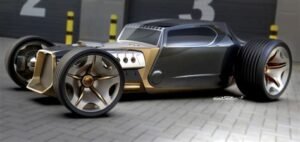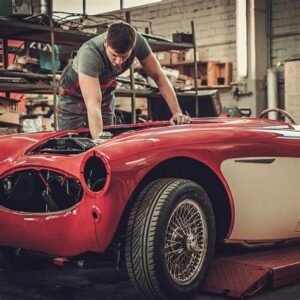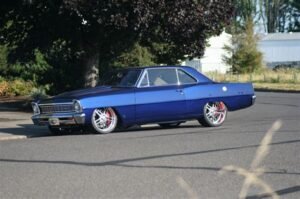
Classic cars occupy a special place in our hearts and take us to another time, yet they still manage to give a sense of class and taste. But other than aesthetic fascination, these marvels of automotive engineering often hide a few surprises of unexploited performance potential. With the right upgrades, you may easily transform your classic car into a real head-turner on the road while bringing back its spirit and enhancing driving pleasure. In this in-depth guide, we take you through various classic car performance upgrades-from engine improvements to suspension changes-to let you unleash hidden power within your favorite retro car.
Improving Power and Economy: Engine Upgrades
The engine is the heart of any classic car. Engine modifications are described as one of the main building blocks of performance enhancements, introducing significant power output increases, torque, and overall driveability. Modifications will range from simple tricks to truly elaborate overhauls, each designed to meet your individual needs and budget.
Engine Tuning: Unleashing the Power Within
Engine tuning involves refining the electronic control unit inside the engine, which controls the delivery of fuel, ignition timing, and several other critical functions. A professional tune can refine those parameters for more responsive throttle, smoother acceleration, and better economy.
Benefits of Engine Tuning:
- Increased horsepower and torque
- Improvement in fuel economy
- Smoothness in idle and acceleration
- Optimized performance of an engine
Intake and Exhaust Systems: Breathing Easy
These are indeed the intake and exhaust systems, which regulate the flow of air and exhaust gases in and out of the engine and hence very vital in its performance. Modifications on both systems can improve airflow notably and lead to greater power with a more exciting exhaust note.
Intake Manifolds: Maximizing Airflow
The intake manifold is the passageway for air on its way to the cylinders. A high-flow intake manifold with bigger ports and optimally-designed runners can better facilitate air volume and speed inside the intake, translating into increased horsepower and torque.
Exhaust Headers: Freeing the Flow
Exhaust headers replace the production exhaust manifold with a far more efficient avenue of escape for those gases. Headers with larger diameter pipes and optimized tube lengths minimize backpressure, allowing maximum exhaust flow and more engine power.
Engine Overhaul: A Foundation for Performance
An overhaul is the last option for those who want much better performance. In this full procedure, ground-up rebuilding of the engine, replacement of worn parts and upgrading the components, and optimization of its overall performance are involved.
Engine Components:
- Pistons and connecting rods
- Crankshaft
- Valvetrain: camshafts, valves
- Cylinder head
- Engine block
Benefits of Engine Overhaul:
- Horse Power and Torque Increased
- Improved Reliability and Long Life
- Reduced emissions
- Improved fuel efficiency
Handling and Control: Suspension and Braking Upgrades
One of the things that can be said about classic cars is that they possess a certain character to drive. Handling and braking, however, have never been their strong suits as compared to modern vehicles. The suspension and braking upgrade will help in making such cars more stable, responsive, and powerful in handling.
Suspension Improvements: Cornering with Confidence
It is impossible to overestimate the role of the suspension system in car handling and ride. Depending on the quality and type of suspension components fitted, improvements in cornering, handling, and general driving can be substantial.
Shock Absorbers: Dampening the Ride
The shock absorber controls the movement of the suspension, damps the oscillation, and keeps the vehicle stable. Changing to performance-oriented shocks with adjustable damping will improve cornering, reduce body roll, and result in a much better ride quality.
Springs: Controlling Body Motion
Springs offer a base of support and resistance to suspension movement while providing support and resistance to said movement. Replacing the much softer stock springs with much stiffer, lower versions will reduce body roll, corner better, and generally improve overall handling dynamics.
Sway Bars: Stabilizing the Ride
Also known as anti-roll bars, sway bars link the suspension together on either side of the vehicle. Upgrading to thicker sway bars increases stiffness, which reduces body roll in corners and enhances handling precision.
Braking System Upgrades: Stopping Power with Precision
It is for this reason that the braking system, for this purpose, assumes great importance, enabling safe and controlled driving. This could be improved through upgrading, where increased stopping power, better responsiveness, and improved feel may be realized.
Brake Pads and Rotors: Friction and Heat Management
Brake pads provide the initial friction for the stop, while rotors dissipate the heat generated during braking. High-performance brake pads have a higher friction coefficient, while larger, vented rotors offer improved stopping power, resistance to fade, and generally improved performance in braking.
Brake Lines and Calipers: Delivering Fluid and Force
Brake lines carry hydraulic fluid from the master cylinder to the calipers, which squeeze the brake pads against the rotors. High-performance brake lines with smaller bores and made of braided stainless steel will reduce fluid expansion and hence quicken the response of the brakes.
Styling and Aesthetics: A Touch of Elegance
Beyond performance, classic car upgrades often go to the extent of improving the aesthetics of the car by giving it a unique character and an enduring appeal. A few changes may come in with a lot of subtleness, while others can change the entire look and feel and provide you with a chance to express yourself.
Exterior Modifications: Heads Turner on Road
Exterior modification can make a classic car look totally different and add visual panache for better road presence.
Wheels and Tires: Rolling in Style
The type and size of wheels and tires can make a major difference in the appearance and performance of any classic car. Larger wheels and tires with a wider profile will definitely make a classic car look better, while performance tires will give it a great amount of grip and better handling.
Body Kits and Spoilers: Aerodynamics and Style
Spoilers and body kits add aggressive styling elements that help enhance a car’s aesthetic appeal with improved aerodynamics. They could also reduce drag and increase stability when driving at higher speeds.
Paint and Chrome: A Timeless Shine
A fresh coat of paint and some detailing with chrome give a classic car a new life, forming a look exactly like it just rolled out of the assembly line or adding that bit of personalization one may want.
Interior Upgrades: Comfort and Luxury
Interior upgrades can make a driver and occupants’ surroundings more comfortable and better appointed in which to travel.
Seats and Upholstery: To Comfort and Style
New upholstery can replace worn-out seats to add comfort, style, and general feel to the interior.
Dashboard and Gauges: A Modern Touch
Adding modern instrumentation and gauges to the dashboard can add functionality and make the driving experience much more driver-centered.
Sound Systems: A Symphony on Wheels
Complete any modern vehicle with a sound system made of the best speakers and an efficient amplifier. Indeed, going high gives the car audio a richer listening experience.
Performance upgrades for classic cars are an emotional and detailed journey. Keeping in mind the objective, budget, and the professional’s assistance, this hidden performance potential of your dear classic ride can be transformed and shaped to be a real witness of style and power.




